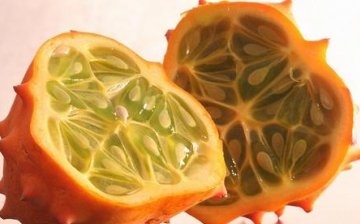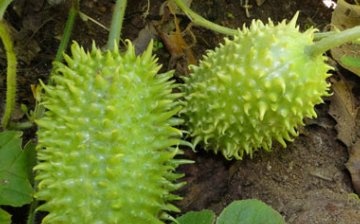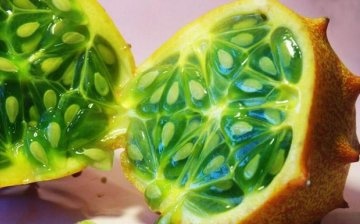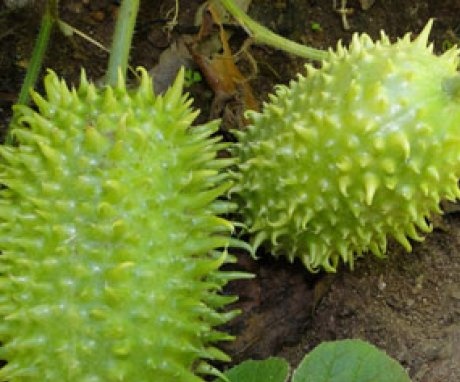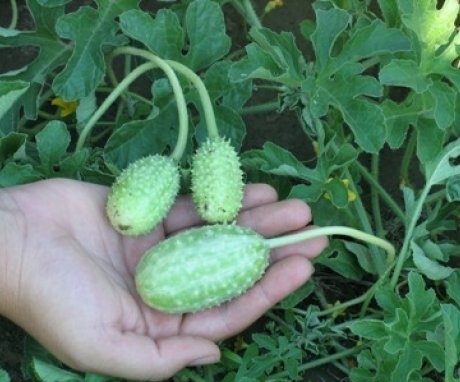Antilles cucumber: characteristics, care, reproduction and use
Antillean cucumber resembles ordinary cucumber not only in taste. Their care and reproduction are also similar, so it will be habitual for residents of Europe and Russia.
Content:
- General information about the Antillean cucumber
- Antillean cucumber care
- Antillean cucumber propagation
- Useful properties and uses of Antillean cucumber
General information about the Antillean cucumber
Antilles cucumber belongs to the pumpkin family and has many names: anguria, horned cucumber, kiwano. it the plant is a vine, the stems of which can be up to 4 meters long. They are pubescent and have many tendrils on them, with the help of which the branches cling to neighboring plants and stretch up to the sun.
Plant characteristic:
- The leaves are large, oval, cut, curly, resembling watermelon in appearance, but have sharp thorns.
- The fruits of the Antillean cucumber are small in size, only up to 8 cm in length. They have a cylindrical shape and are covered with soft leathery thorns on top.
When young, they are colored green, but the fruit is considered ripe when the skin acquires a marbled yellow tone. The fruits ripen on the plant 2.5 months after planting. Up to 200 cucumbers can be harvested from one bush.
Also, its advantage is that the plant will bear fruit until the last month of autumn, when frosts begin. The taste of the fruit is similar to the common cucumber, but if you pickle them, you get a real delicacy.
The homeland of the Antilles cucumber is America, where this product was widely used in local cuisine.
But with the arrival of Europeans with seeds of common cucumbers to these lands, this culture began to lose popularity. This plant is very thermophilic, so normal temperatures for it are +27 degrees, and it will also feel normal at a temperature of +15 degrees. But with a prolonged decrease in degrees to +5 or with frosts, the vines of the Antillean cucumber die.
Antillean cucumber care
The plant does not like strong shading. With a lack of sun, the branches will not stretch, and the ripening of the fruits and even their appearance will deteriorate in many ways. Therefore, for landing it is better choose a bright sunny place... Given that the Antillean cucumber is a very prolific plant, much space is not needed.
It is also worth considering that anguria does not tolerate windy weather well, so the place should be sheltered from wind and drafts.
Secrets of growing Antillean cucumber:
- The soil must be fertile and well-drained.
- The plant is hygrophilous, but does not tolerate stagnant water.
- Also regular feeding is necessary... Any organic and natural fertilizers are suitable for this.
- The regularity of feeding should be constant and should be done once every 10 days.
- When the soil dries out, abundant watering is required.
- When growing Antillean cucumber in the beds, you must regularly remove the weeds.
- After watering, it is worth loosing the ground so that a continuous layer does not form, which prevents the passage of air to the roots.
Fruits appear on the branches of the second order. Therefore, in order for the harvest to be rich, when the first ovary appears, it is necessary to break off or pinch the tops of the main shoots.This will allow the secondary branches to develop faster and stronger and a large number of fruits will be tied on them.
Antilles cucumber is resistant to various parasites and diseases. And this is another great advantage of this plant, since its distant relative, the cucumber, is often prone to powdery mildew.
Antillean cucumber propagation
Since the Antillean cucumber is a thermophilic plant, and propagates by seeds, in our area it is recommended to plant ready-made seedlings in open ground. To do this, you need to take peat soil and pour it into special paper cups for seedlings. Soak the seeds for a day and plant 2-3 pieces in cups. After germination, make sure that the soil does not dry out. After three weeks, the sprouts can already be planted in open ground if the weather is consistently warm.
With prolonged frosts, it is recommended to plant seedlings in a greenhouse.
Each plant should be planted at the supports, to which, subsequently, it will be possible to tie up the climbing branches. The distance between the bushes should be approximately 0.5 meters. If the cucumber is planted along the fence, there should be 30 cm more free space between them.
Antillean cucumber can be planted in place of legumes, potatoes or cabbage... If the predecessors belonged to the pumpkin family, then anguria will grow poorly on such a site.
Useful properties and uses of Antillean cucumber
Antilles cucumber is recommended for people with diseases of the cardiovascular system and gastrointestinal tract. Due to the content of magnesium and calcium salts, a large amount of vitamins and sugar, such fruits have a beneficial effect on the human body.
Another advantage of the Antilles cucumber is that it does not accumulate nitrates in its fruits. That is, in the modern world, it is one of the safest fruits to buy in the market or in the supermarket.
The green fruits of the Antilles cucumber are mainly used:
- Practically the same procedures are performed with them as with the usual cucumbers: pickled, make salads, canned for the winter.
- Also, the fruits are well stored, and in the presence of a cool basement or any other room, such miracle cucumbers can be eaten fresh even for the New Year.
- In mature form, anguria fruits are practically not used, although they are very beautiful and can be used to decorate the table.
In addition to its edible properties, the Antillean cucumber is valuable as an ornamental plant. The fruits have a regular and beautiful shape, and the thorns give them additional exotic look... The plant itself densely wraps around the supports and can serve as a wonderful decoration for the garden. Looks especially beautiful when planted near fences and arches.
Decorative beautiful, carved leaves, densely located on the branches and create an excellent shade.
Anguria is also used for landscaping the balcony. This will require a small tub and regular tying of branches. Care is no different from growing in a garden: regular watering, top dressing and plowing of the earth.
More information can be found in the video.



